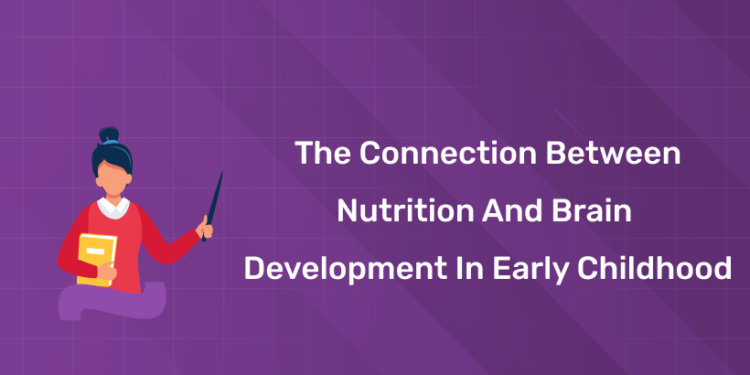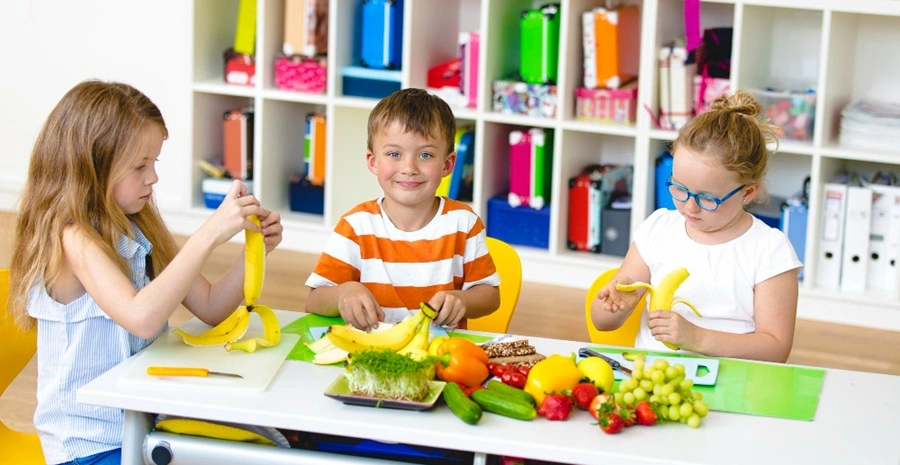Table of Contents
In early childhood education we focus on language, maths, sensorial work and social skills but one foundation that underpins all of these is nutrition. What children eat (and when, how and with whom) has a profound impact on how their brains develop and how well they learn. Whether you’re a parent, an aspiring Montessori teacher or an educator looking to deepen your understanding: this article explores the science and practice of how nutrition connects with brain development in early childhood.
Register for the Entri Elevate Montessori Teacher Training Program! Click here to join!
Why Nutrition Matters for Brain Development in Early Childhood
From the womb to the first few years of life the brain is growing rapidly: neuron and synapse formation, myelination (insulation of nerve fibres), dendritic branching and building the networks that underlie thinking, memory, attention and emotional regulation. What children eat matters a lot in this period.
The early years
Research shows nutrition plays a big role from late pregnancy to infancy and up to about age 3 when the brain’s plasticity and growth is at its peak.
If nutrients are inadequate during these windows the structure and capacity of the brain can be affected. For example:
- Reduced myelination, fewer dendritic branches, decreased glial cell production.
- Altered brain morphology and eventual cognitive outcomes.
- The big picture: early nutrition impacts on long term brain function, cognition, behaviour and productivity.
Key nutrients and brain specific roles
Some nutrients are more important for brain development:
- Protein, iron, zinc, copper, choline, iodine, long chain polyunsaturated fatty acids (LC-PUFAs) e.g. DHA.
- Carbohydrates for glucose (the brain’s fuel) plus vitamins and minerals for neurotransmitter production and myelination.
- Diet quality and overall patterns matter (not just single nutrients). A 2023 study found children with better diet quality had larger brain volumes and higher IQ scores.
Impact on cognition, learning & behaviour
When brain development is supported by good nutrition children show:
- Better attention, memory, problem solving ability.
- Improved academic performance and lower risk of behaviour issues.
>And conversely malnutrition or poor diet quality can result in delays in language, fine motor skills, learning challenges and long term deficits.
Integrating Nutrition Awareness into a Montessori‑Inspired Environment
1: What is the primary focus of the first plane of development in the Montessori method?
As an educator (or aspiring Montessori teacher), how do you bring this scientific understanding into your classroom and practice? The Montessori approach offers rich possibilities for weaving nutrition and brain‑health into everyday life.
1. Practical Life & Sensorial Work Linked to Food & Nutrition
In Montessori classrooms, children engage in practical‑life activities (washing, pouring, preparing, serving). These can directly involve healthy foods:
- Involve children in washing, chopping, peeling fruit, vegetables or legumes. This supports fine motor skills, sensory exploration (touch, texture, taste) and gives awareness of food as more than fuel.
- Use sensor‑tables where children explore whole grains, pulses, seeds, leafy greens, helping them connect food to the body and brain’s needs.
- Provide opportunities for children to choose from a limited set of healthy snack options; this supports independence and internalising healthy habits.
2. Prepared Environment for Healthy Eating
- Use child‑sized utensils, plates, tables so children can serve themselves and participate in meal or snack time. This enhances independence, agency, and respect for food.
- Design snack/meal areas free from distractions (TV, mobile) so children can eat mindfully, the brain benefits when meals are calm, social, and interactive.
- Rather than only academic‑materials, have clear spaces where children can learn about the body, brain, nutrition (charts, visuals) and where food preparation or tasting activities can occur.
3. Movement, Cognition & Nutrition- The Trio
Montessori emphasises movement as part of learning. Combine movement, cognitive tasks and healthy eating for brain‑body synergy:
- After a movement activity or gross‑motor task, follow with snack time: children learn that their body (and brain) needs fuel after physical work.
- Encourage physical activity (outdoor play, walking, balancing) and link it to how the brain grows when the body moves, and how nutrition supports both.
- Discuss with children (in age‑appropriate language) how “our brain needs good food to think, and our body to move”.
4. Exploring Food Origins, Culture & Brain Health
In the Indian context, you have rich culinary traditions and diverse foods, this is an advantage.
- Encourage simple gardening, planting legumes or herbs in the classroom or home, and linking this to brain‑growth (“look how this herb grew, our brain grows too”).
- Explore local foods rich in brain‑nourishment, e.g., fresh fish (omega‑3s) in coastal regions, lentils/ dals (iron, protein) which many children have access to.
- Use parent involvement: share newsletters on brain‑healthy foods, organise snack‑sharing where children bring a healthy item and talk about why it helps the brain.
- Reflect on culture: children learn that in their region, certain foods support their brain and body, gives context, relevance and deeper engagement.
5. Teacher Awareness & Training
As an educator you’ll be more effective if you understand the behind‑the‑scenes science and design. Training plays a big role. For example:
- The Entri Montessori Teacher Training Course immerses you in Montessori philosophy (prepared environment, sensorial curriculum, independence) and gives you frameworks to integrate health and nutrition into classroom design.
- You’ll learn how to observe children (Montessori‑style) and note when they are ready for more responsibility (serving food, preparing snack), when they might need additional support (if poor nutrition is visible), and how to design meaningful food‑linked activities.
- With such training you become not just a teacher of academic content, but a guide for holistic brain and body development, helping children become well‑nourished learners and well‑nourished thinkers.
Get Certified & Start Your Montessori Career
Montessori Teacher Training Course by Entri App: Gain expert skills, earn certification, and kickstart your teaching career.
Join Now!Practical Guidelines & Strategies for Educators and Parents
For Parents & Guardians – Bringing Brain-friendly Nutrition into your Family
- Make whole foods with brain supporting nutrients a priority: eggs, legumes (and dals), leafy greens, fish (if you’re not vegetarian), nuts and seeds, dairy (or alternatives) and whole grains – these are all big helps for your child’s brain.
- Get kids off to a good start with a healthy breakfast. This really sets them up for learning and staying focused.
- Try to limit processed and sugary snacks and drinks – the science is pretty clear that these are linked to poorer brain development and lower grades.
- Get the kids involved with food too – take them shopping, let them help with meal planning and cooking, or even just getting snacks ready. This helps them learn about food and eat it more willingly.
- Get them moving outdoors, playing and getting some restful sleep – when the body is active and rested, the brain benefits too.
- Help kids make the connection between food and the brain: just say something simple like “This food will help your brain learn more” and see how they take to it.
For Montessori Educators / Aspiring Teachers – Putting Brain-friendly Nutrition into practice
- Run snack or meal times in ways that respect the kids’ independence – so let them help themselves to small portions of fruit or veg, for example.
- Find ways to link food into your lessons – so maybe sort legumes, or explore the texture of different grains and seeds – or just get the kids to help with washing and prepping some fruit.
- Make use of visual aids in the classroom – a “brain food corner” with posters or pictures that show the sorts of foods that are good for the brain, for example.
- Try to get some movement in during the day, followed by a snack or activity to help the kids focus – so maybe after a lot of running around, get them to sit down and eat some food and talk about how their brain works.
- Get the parents on board too – send them a note every month with some tips for healthy eating and learning, or invite them to join in with some simple cooking.
- When you’re training to be a teacher or doing some professional development, think about how nutrition and energy affect the kids in your care – and how you can make small changes to the way you run snack and meal times to make a big difference.
A Sample Weekly Plan to Focus on Brain Health
Here’s a simple plan you can use in your own classroom or home:
Monday: “Good Food for My Brain”
- Practical Life: get the kids to help arrange some fruit on a plate
- Sensorial: match up cards with foods that are good for the brain
- Snack time: get the kids to serve themselves some fruit and talk about how their brain is like a garden – it needs good soil and water (good food) to grow.
Tuesday: “Move and Think”
- Get the kids out for some exercise – maybe a bit of yoga or just a quick game to get them running around
- Talk to them about how exercise makes their brain strong, and how they need to eat healthy food to make it work properly
- Snack: get the kids to help make some whole grain crackers with healthy dips – like peanut butter or hummus.
Wednesday: “Where Does Food Come From?”
- Get the kids to help plant or grow some sort of food – maybe some lentils or beans
- Explore with them how different foods smell and taste when they’re raw vs cooked
- Snack: get the kids to help make some mini-dal or veg sticks with hummus – and talk to them about where the food came from and how it helps their brain and body.
Thursday: Theme: “Brain Fuel Choice”
-
Sensorial: Two trays of snack options: one heavily processed (chips/sweet snacks) vs one healthy (nuts, seeds, fruits). Children discuss which one is better and why.
-
Practical‑life: Children serve healthy snack themselves.
-
Snack: Balanced snack; discussion: “What makes this snack good for our brain? What happens if we choose sweets only?”
Friday: Theme: “Reflect & Share”
-
Reflection circle: Children talk about how they felt this week—noticed more energy? Better focus?
-
Snack: Children bring one healthy item from home (with parent note) and share with class; teacher links each item to brain nutrients.
-
Wrap‑up: Teacher summarises “This week we helped our brain grow. Next week we’ll continue…”
The Cultural Insights
When applying these ideas in India or similar Asian contexts, a few considerations help make the approach relevant and culturally grounded:
- Use local staple foods: Think legumes/dals, rice/whole‑grain alternatives, traditional vegetables, fish in coastal zones, seeds and nuts like groundnuts, sesame, flaxseed, many of these have brain‑supporting nutrients.
- Recognise cost and accessibility: In many regions, fresh fish or certain nuts may be expensive. Use plant‑based proteins, pulses, eggs, yoghurt (if culturally appropriate) as affordable brain‑food options.
- Honor food culture and habits: Incorporate local snacks (healthy variants) and involve families so that snack time in school and home align.
- Educate on transitions: With rapid lifestyle changes and processed foods entering many households, educators and parents play a critical role in bridging new habits with tradition and health.
- Multilingual/cultural communication: Use simple, local language when discussing “brain food”, “strong body”, “good thinking” to ensure children and families understand and connect with the message.
Get Certified & Start Your Montessori Career
Montessori Teacher Training Course by Entri App: Gain expert skills, earn certification, and kickstart your teaching career.
Join Now!How Entri’s Montessori Teacher Training Course Aligns with These Insights
If you’re an aspiring Montessori educator, the training you choose can make a significant difference in how effectively you integrate nutrition and brain‑health into your classroom practice. The Entri Montessori Teacher Training Course does just that in several ways:
- It immerses you in Montessori philosophy and pedagogy: prepared environment, sensorial work, independence, observation, these form the framework for integrating nutrition, movement and brain‑health into everyday learning.
- It encourages you to design child‑centred, practical life activities, including food‑handling, self‑service, snack‑preparation, which supports children’s brain development alongside their independence.
- It guides classroom environment design: showing you how to set up snack/meal areas, movement zones, and reflection spaces, all of which may influence cognitive growth.
- It links theory and practice: Connecting child development science (including brain development, nutrition) with the Montessori methods so you understand why you’re doing food‑related activities, not just how.
- It prepares you for local adaptation: The Entri course helps you adapt Montessori practices to local culture, food habits and community involvement.
>By enrolling, you are equipping yourself not only to teach letters, numbers and sensorial materials, but to become a guide who supports whole‑child learning: body, brain and independent mind.
Takeaways
- Brain development in early childhood is highly sensitive to nutrition, diet influences structure (neurons, myelination, dendrites) and function (neurotransmitters, cognition).
- Key nutrients for brain health are protein, iron, zinc, choline, iodine, omega‑3 fatty acids and a quality diet overall, not just single “brain foods”.
- Poor nutrition or high processed/sugary diets are linked to smaller brain volumes, lower cognitive outcomes, poorer academic achievement and behavioural issues.
- Montessori inspired classrooms offer powerful opportunities to integrate nutrition and brain health: through practical life, sensorial work, movement, independence, snack/meal routines and food education.
- In India, applying these principles means using local foods, culturally meaningful activities, parent engagement and adaptable practices.
- Training in Montessori methods empowers educators to embed brain healthy nutrition practices into their classroom design, pedagogy and daily rhythm.
- Ultimately: When children’s brains are well fed, nourished and active, they are better able to engage, learn, explore and thrive. Nutrition isn’t a footnote; it’s part of the foundation of early childhood education.
Conclusion
As you begin (or continue) your journey as a parent, educator or Montessori teacher in training, remember: what children eat, how they move, how their environment supports them, all of this matters deeply for their brains. In the Montessori classroom we don’t separate “learning” from “living” from “health”. They are intertwined.
By designing thoughtful snack routines, movement linked activities, food preparation experiences and brain friendly classroom spaces you are helping children build neural networks, cognitive skills and healthy habits that will serve them not just today but long into their future.
If you want to deepen your skills and become the kind of educator who supports whole child growth in body, brain and mind then enrolling in the Entri Montessori Teacher Training Course is a meaningful step. It’s more than certification; it’s empowerment to create rich learning environments where nutrition and cognition go hand in hand.
| Also Read | |
| 5 Ways Montessori Teacher Training Benefits Children | |
| What Qualifications Do You Need for Kindergarten Teacher Jobs? |
|
| Montessori Pink Tower Making | |
| Knobbed Cylinders in Montessori | |
Get Certified & Start Your Montessori Career
Montessori Teacher Training Course by Entri App: Gain expert skills, earn certification, and kickstart your teaching career.
Join Now!Frequently Asked Questions
How does nutrition affect brain development in early childhood?
Nutrition provides the essential building blocks, proteins, fats, vitamins, and minerals needed for brain growth, neural connectivity, and cognitive development during early years.
Which nutrients are most important for brain development?
Iron, DHA (Omega-3 fatty acids), iodine, zinc, and B-vitamins are critical for brain structure, neurotransmission, and memory formation.
What happens if a child is malnourished during early brain development?
Malnutrition can lead to delayed learning, poor memory, reduced attention span, and long-term cognitive deficits that affect school readiness.
How can Montessori classrooms support good nutrition?
Through Practical Life activities like washing fruits, serving food, and gardening, Montessori classrooms naturally teach healthy eating habits and independence.
What foods are best for boosting a child’s brain health?
Include eggs, leafy greens, whole grains, nuts, milk, fish, and fresh fruits. These support memory, attention, and overall cognitive function.
Can poor nutrition affect a child’s behaviour?
Yes. Deficiencies in key nutrients can cause irritability, hyperactivity, or fatigue, which can interfere with classroom focus and social interaction.
How can teachers and parents collaborate on child nutrition?
Regular communication, shared meal plans, and workshops can align home and school efforts to ensure consistent, balanced nutrition for the child.
How can aspiring Montessori educators learn to manage nutrition in classrooms?
Through structured training like Entri’s Montessori Course, which includes modules on classroom health, child nutrition, and holistic early education practices.














